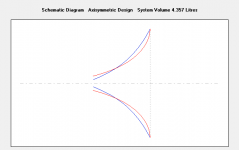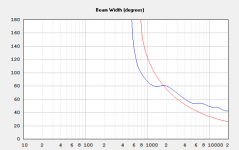can someone tell me what's behind the trend of going ever lower with x-over points with compression drivers and horns?
I hate to guess on why I found it to be true because I'm probably wrong, but in my experimenting with different drivers and crossovers with my horns, raising the crossover frequency dramatically reduced resolution and that velvety human voice that is most enthralling about my setup.
Re LF 'definition', close your eyes, cup your ears with fingers spread apart a bit to roll off the lows and hear how 'bright' the world becomes and decide for yourself if you need the LF to help locate sounds.
Another way to make you lose interest in LF 'clarity' per se is to listen to a really 'sweet' sounding [super wide BW] 15" [like you ordered] XO'd at up to even the Altec 604's 1.6 kHz. I've heard washing machines with more 'clarity'.
What inspired you to say this? I was thinking a lower crossover would be less detectable since the frequencies towards the bass become less and less location clear, so thus, it blends so much better with the speaker its sharing frequency with even though it is multiple source, it will less like so.
Thats a bit of an over simplification isn't it? Depending on how big the object is the larger waves are going to have an easier time going around it, and if the object is very large now you have a ton reflective energy that would not of been there before.
Last edited:
I would agree with this.
And a good example for off-axis response is to put something absorbing (hot huge!) between you and a speaker to block the direct sound. Hear anything? That is ALL off axis.
Indeed! Came back pretty quick to 'round out' a bit my impromptu soapbox rant, but beat me to it.
GM
what system of measurement is used for "resolution"? is it a percentage?I hate to guess on why I found it to be true because I'm probably wrong, but in my experimenting with different drivers and crossovers with my horns, raising the crossover frequency dramatically reduced resolution and that velvety human voice that is most enthralling about my setup.
perception of low level distortion is a funny fickle thing. as a studio technique it can be used to make sounds "thicker" or more "edgy" and as i've used this very thing i can say that difference between "thick" and "edgy" is simply which of the harmonic series i've chosen to manipulate, even or odd.
do i want this occurring in a loudspeaker...? it would depend of the net result and that's subjective. as i value clean spl and dynamic range i've favored going as far up the range as i could without giving myself grief with directivity.
not saying my solution is better in any way but for me the subjective result is better.
That's not entirely accurate....since the frequencies towards the bass become less and less location clear...
Regarding the VOTT I am sure that it will not meet all the criteria of the thread title. And I assume the same accounts for the 604.
Regards
Charles

what system of measurement is used for "resolution"? is it a percentage?
I probably should have called it "apparent resolution" or subjective resolution. When I raise the xo, even when I keep the target curve the same, male vocals have less detail in the midrange, like I'm listening to a lesser system. Veiled, smoothed over, hope that makes sense.
Where I find hornresp useful is showing the relative effects of tweaks to certain horn types. Waveguides aren't bad at holding a pattern low.A generalization
Don't read into the throat size difference, the LeCleach is just longer.
Attachments
The lack of localization in bass frequencies is an old audio chestnut that deserves to go away. Yes, it's convenient to combine bass into mono for limited systems. But it isn't a sonic freebee that can be done without compromise. Something to keep in mind.
I’m glad you said it and not me, I’ve always felt I had no issue sourcing bass in the location aspect, but you must admit, however slight, it is less distinguishable than higher frequencies, maybe because of room interaction or wave size.
When it gets very low, yes. For me that generally around 30 Hz. Midrange tones are the easiest, treble not so easy. I test with sharply filtered pink noise which is easier to locate than pure tones in any range.
Sorry for the OT - I just don't like seeing these old myths repeated.
Sorry for the OT - I just don't like seeing these old myths repeated.
Well done question got buried back there, but if someone had answers they would spoken up I guess.
I do have a current question about exit size...I’ve actually read people suggesting that exit size has no influence on performance of range or dispersion....I’m pretty sure that’s wrong but can someone confirm that aspect? I was taught, here that a large exit performs better down low and a smaller performs better up high. Performs being a somewhat ambiguous description. I’d think that exit size has an affect no different than diaphragm size of a dynamic driver. As far as range, exit size seems to affect it, but I don’t understand why if the diaphragm is the same size like with the 2450/2451 or 950/951. Oh the top of my head the 2450 has higher extension than the 2451, judging by the chart. How’s that make sense.
Does anyone know of an adapter for the 2451 to fit the more common 4 bolt pattern?
I do have a current question about exit size...I’ve actually read people suggesting that exit size has no influence on performance of range or dispersion....I’m pretty sure that’s wrong but can someone confirm that aspect? I was taught, here that a large exit performs better down low and a smaller performs better up high. Performs being a somewhat ambiguous description. I’d think that exit size has an affect no different than diaphragm size of a dynamic driver. As far as range, exit size seems to affect it, but I don’t understand why if the diaphragm is the same size like with the 2450/2451 or 950/951. Oh the top of my head the 2450 has higher extension than the 2451, judging by the chart. How’s that make sense.
Does anyone know of an adapter for the 2451 to fit the more common 4 bolt pattern?
This has been heavily discussed in other threads over the years, so we don't need to go into it here.I'd say that bass instruments are usually located via their overtones and initial transients and not their fundamentals.
Generally we read the the smaller exit drivers go higher, flatter. Some super tweeter compression drivers are 0.75" Altec did many 1.4" considered a compromise between 1" and 2"....I’ve actually read people suggesting that exit size has no influence on performance of range or dispersion....I’m pretty sure that’s wrong but can someone confirm that aspect?
Looking at some on axis plots of various drivers, I don't always see that it follows. Will be interested to read what others have found.

I've wondered about the push for CDs to reach lower too.
I get the desire for them to reach down to where a cone begins to lose pistonic control.
I've heard for a 12", that's 700-900Hz depending. So for a CD to get to 600-700Hz solves that.
And if someone wants to use a 15", I can see they would want the CD to reach a bit lower still.
I'm also beginning to intuit the directivity pass-off between CD and cone, but that seems to be size-of-horn related vs cone diameter, more than anything else.
And it seem like it takes a really big *** horn to utilize the newer CD's push into lower territory... Horn's that are too expensive to make according to B&C's sales manager...
So why the push lower? I sure dunno, unless it's about the whole point-source extension, acoustic center co-location thing.
Cause for example, I've been learning firsthand that synergies have issues...throat to horn matching, and straight sided conical wall problems....but still, the acoustic co-location lets them sound really good.
Maybe the extended range CD's will help acoustic location.
I don't think the push lower is about xover in the vocal range. There's still gonna be one in there no matter what the CD can do...
This is all very recognizable and I fully agree with your statements.
I also endorse your observations regarding synergies, specifically in the nearfield at lower output levels. There's unmistakably a horn-like signature. In far field conditions this is less apparent, but it makes me wonder whether this could become annoying at home in the long run.
GM's remark about high crossover points with 15" woofers versus midrange clarity reminds me of intermodulation issues, as discussed before.
Lately, I've been listening to some small 2-way loudspeakers that suffer from lack of midrange clarity, especially with bass heavy electronic music at higher SPL.
For large 2-ways it's about the reciprocity between bandwidth (extension), directivity and the implications of 'size' (of drivers, cab and horn) versus the crossover.
Some people prefer multi-ways in order to bypass some of the limitations, thus introducing another set of challenges.
Size does matter a lot in combatting the limitations of a 2-way. A bigger horn facilitates a lower crossover point as well improved directivity, which positively affects the low/midrange.
Finally, we can conclude that these considerations lead us back to the pioneers.
Last edited:
- Home
- Loudspeakers
- Multi-Way
- Is it possible to cover the whole spectrum, high SPL, low distortion with a 2-way?

